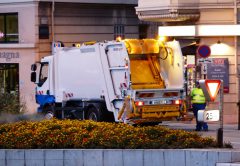Volvo presented an automated approach to waste disposal. The original concept provides robots as refuse collectors and an autonomous garbage truck which is being tested at the moment.
Smart City Concepts
The future city will be digital and automated, but according to a study from Fraunhofer IAO and PricewaterhouseCooper (PwC) many cities have so far failed to develop specific measures for the urban digitization. Meanwhile the industry is generating concepts and strategies, especially for urban areas. In September 2015 Volvo brought forward a first draft for an automated refuse collector. The robots would collect garbage cans and bring them to the next garbage truck. The company also issued garbage cans equipped with sensors to communicate with the robots. The research concept called ROAR was the cornerstone for the testing procedures.
Volvo Autonomous Refuse Truck
Back then Volvo announced a cooperation with the waste disposal company Renova in order to test autonomous refuse trucks. Today Volvo is truly testing autonomous trucks that are assigned to the Renova waste disposal fleet. So the autonomous refuse truck has already become reality. It was developed on the basis of already operating autonomous mining trucks. However, an urban infrastructure is much more demanding for an autonomous vehicle than a mine site. Lidar systems are a necessary part of the vehicles’ sensor equipment as they monitor and map the environment.
Testing Autonomous Trucks
The learning process is simple: the trucks move at walking pace in front of the refuse collectors. During the first trip they are controlled manually, learning and mapping their respective route with all stops via GPS and Lidar. The second run will be processed automatically because the truck can use the previously collected data to orient itself and to avoid obstacles like parked cars.
The refuse collectors leave the autonomous truck after the first stop and start make their way through the streets in parallel with the vehicle. In this manner waste collection efficiency shall improve significantly as the workers no longer have to hop on the vehicle again and again. Moreover the computer is driving more efficient saving fuel and reducing emissions.
The pilot project is running until the end of 2017 and will be evaluated afterwards. The analysis will not only refer to technical feasibility but also to acceptance of the technology by the public.
About the author:
David Fluhr is journalist and owner of the digital magazine “Autonomes Fahren & Co”. He is reporting regularly about trends and technologies in the fields Autonomous Driving, HMI, Telematics and Robotics. Link to his site: http://www.autonomes-fahren.de

